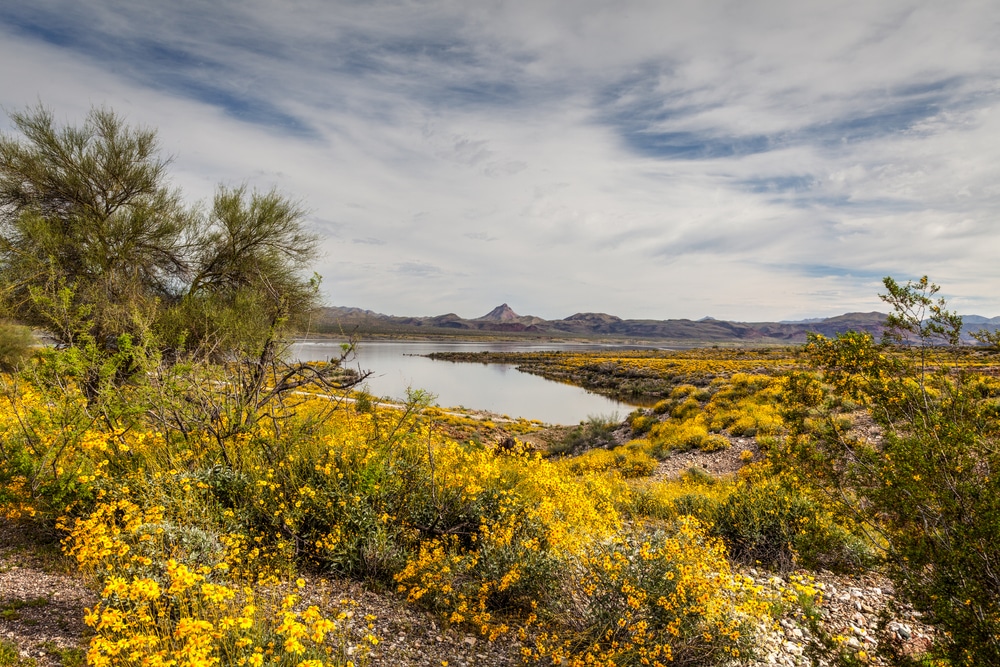- Privacy
- Terms
- Stay Connected
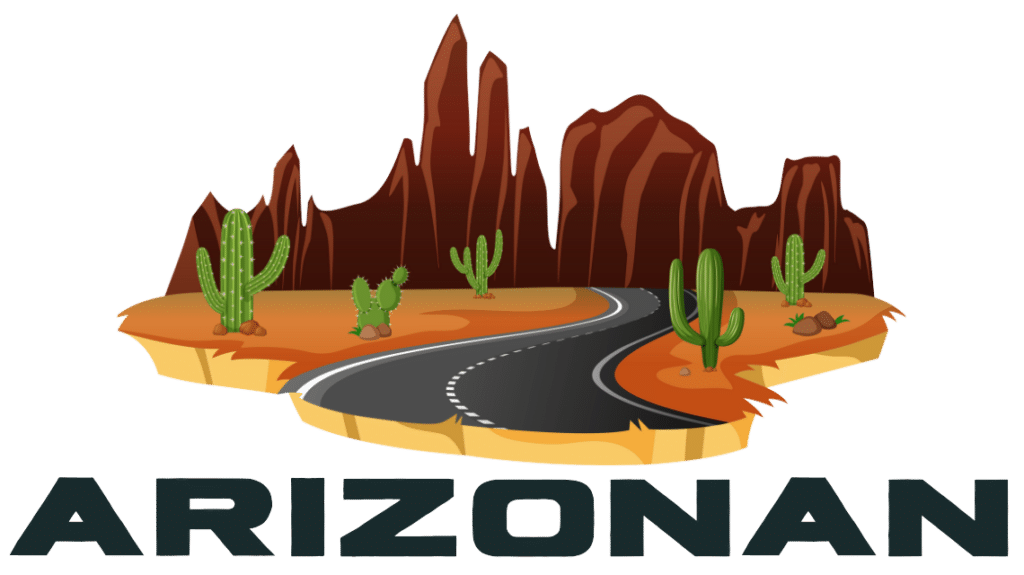

Nestled in the Bill Williams River Valley of western Arizona, Alamo Lake State Park is truly one of Arizona’s best-kept secrets. Located approximately 38 miles north of the small town of Wenden, this remote desert gem offers visitors a welcome escape from the hustle and bustle of everyday life. The park centers around Alamo Lake, a serene body of water created in 1968 with the completion of Alamo Dam by the Army Corps of Engineers primarily for flood control purposes on the Bill Williams River.
The journey to Alamo Lake is part of the experience itself. A paved two-lane road winds through pristine Sonoran Desert landscape, showcasing expansive vistas of saguaro-studded hills and distant mountains. This remoteness contributes to the park’s special atmosphere, with the nearest city lights some 40 miles away, making it an extraordinary destination for stargazers and those seeking solitude in nature.
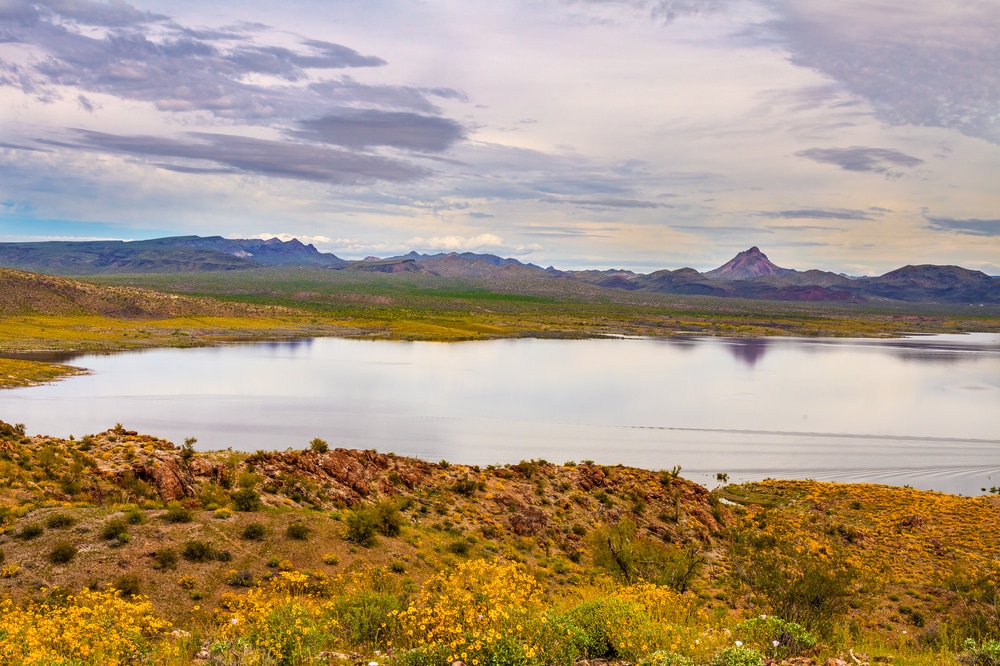
Alamo Lake State Park’s significance to Arizona’s park system lies in its dual role as both a vital flood control mechanism and a premier outdoor recreation destination. The park has earned national recognition as one of Arizona’s best bass and crappie fisheries, attracting anglers from across the country. Beyond fishing, visitors can enjoy boating, hiking, wildlife viewing, and camping in this unique desert setting.
What truly distinguishes Alamo Lake is the stark contrast between the crystal-clear waters of the lake and the rugged desert terrain that surrounds it. This juxtaposition creates a visually stunning environment where desert beauty is reflected off the water’s surface. During spring, the landscape transforms with an abundance of wildflowers, adding splashes of color to the desert palette, making it one of the most picturesque times to visit this remarkable Arizona treasure.

Alamo Lake is renowned for its exceptional bass fishing, particularly for trophy-sized largemouth bass that attract anglers from across the region. The lake also offers abundant populations of crappie, sunfish, and catfish. Spring and fall provide optimal fishing conditions when water temperatures moderate and fish become more active. The Arizona Game and Fish Department regularly stocks the lake, ensuring sustainable fishing opportunities throughout the year.

The expansive 3,500-acre reservoir provides ample space for various boating activities. Two well-maintained boat ramps allow easy access for motorized watercraft. The lake’s numerous quiet coves and inlets create perfect conditions for kayakers and canoeists seeking peaceful exploration. The contrast between crystal-clear water and surrounding desert hills creates a striking visual experience for all boaters.

The park offers diverse overnight accommodations including developed campgrounds with modern amenities like water and electrical hookups, primitive camping areas for those seeking a more rustic experience, and cabin rentals for additional comfort. Most sites feature picnic tables and fire rings, positioned to maximize privacy and scenic views of the lake or desert landscape.

The unique ecosystem where desert meets water attracts an impressive variety of animals. Visitors can observe desert bighorn sheep navigating rocky hillsides, javelina foraging among cacti, coyotes patrolling at dawn and dusk, and various reptile species. The lake serves as a crucial water source for countless bird species, making it an excellent location for birdwatching throughout the year.

Several well-marked trails wind through the desert landscape surrounding the lake, ranging from easy walks suitable for families to more challenging routes with elevation changes. These paths showcase native flora including saguaro cacti, ocotillo, and seasonal wildflowers, while offering panoramic views of the lake and surrounding mountains.

Alamo Lake’s remote location and minimal light pollution create ideal conditions for astronomy enthusiasts. On clear nights, the Milky Way stretches visibly across the sky, while planets, stars, and occasional meteor showers dazzle observers. The park sometimes hosts organized astronomy events where visitors can use telescopes and learn about celestial objects from knowledgeable volunteers.

The dramatic landscape offers countless photographic opportunities throughout the day. Sunrise casts golden light across the water, midday showcases the stark contrast between azure water and rugged desert, while sunset paints the sky and landscape in vibrant oranges and purples. Wildlife, native plants, and night sky photography are particularly rewarding at Alamo Lake.
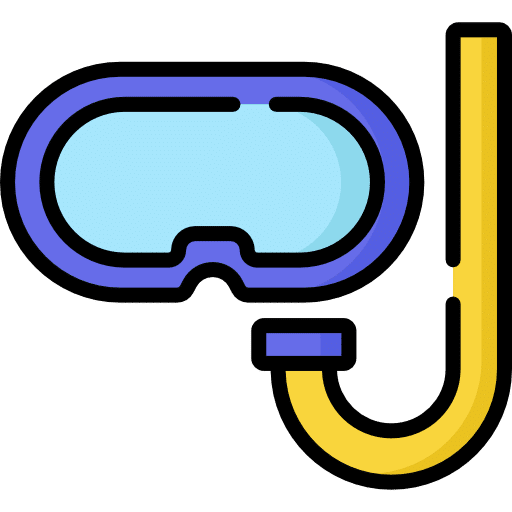
During warmer months, designated swimming areas provide relief from desert heat. The water level fluctuates seasonally based on rainfall and dam operations, so swimming conditions vary throughout the year. No lifeguards are on duty, so visitors should exercise appropriate caution while enjoying the refreshing waters.

Shaded picnic areas with tables are strategically placed throughout the park, offering scenic vistas while providing shelter from the desert sun. These areas make ideal spots for day visitors to enjoy meals while taking in the natural beauty of this unique desert oasis.
Water activities form the cornerstone of recreation at Alamo Lake State Park. The lake’s expansive surface provides ample space for motorized boating, with two paved boat ramps offering convenient water access. The main boat ramp is located in the primary campground area, while a second ramp can be found in the Cholla campground. During periods of high water, a third ramp becomes accessible. Boaters enjoy cruising the lake’s many inlets and coves, water skiing in open areas, or simply relaxing on the water while taking in the desert scenery.
For those preferring human-powered watercraft, Alamo Lake presents an ideal setting for kayaking, canoeing, and paddleboarding. The calm waters and numerous secluded coves create perfect conditions for peaceful paddling adventures. These quieter modes of transportation also allow visitors to get closer to wildlife and explore shallow areas inaccessible to larger boats.
Swimming is permitted throughout the lake, although there are no designated beach areas. Visitors often find their own preferred swimming spots along the shoreline. The lake’s water temperature varies seasonally, with comfortable swimming conditions typically from late spring through early fall. As with all water activities at Alamo Lake, swimmers should exercise caution, as there are no lifeguards on duty.
Fishing at Alamo Lake is world-class, earning the park a reputation as one of Arizona’s premier bass and crappie fishing destinations. The lake is particularly known for its largemouth bass population, with fish ranging from 1-2 pounds being common, while trophy bass exceeding 5 pounds are caught with some regularity. Bass fishing is especially productive during spring spawning season, typically February through May.
The lake also supports healthy populations of crappie, bluegill, sunfish, channel catfish, flathead catfish, and tilapia. Crappie fishing is particularly popular during cooler months, with these tasty panfish often found around submerged brush and timber. Catfishing tends to be best during warmer months and at night. All anglers 10 years and older must possess a valid Arizona fishing license, which can be purchased at the park store or through Arizona Game & Fish Department.
Favorite fishing spots include Andrews Wash on the western shore near the dam, which offers deep water habitat for catfish, and the submerged structure areas between Chai Cove and Spencers Wash along the southern shore. The lake regularly hosts fishing tournaments, particularly for bass, attracting competitors from across the region.
Hiking opportunities at Alamo Lake include several designated trails that showcase the desert environment. The Wild Burro Trail (0.6 miles) follows an exposed ridge connecting the main road to a boat launch ramp, offering expansive views of the lake and surrounding terrain. The shorter Crosscut Trail (0.4 miles) links to one of the campgrounds, while the brief Rattlesnake Overlook Trail (0.1 miles) climbs to a scenic viewpoint. Beyond these maintained paths, visitors can explore cross-country through the desert landscape, discovering the diverse plant life and possibly encountering wildlife.
Photography enthusiasts find endless inspiration at Alamo Lake, from dramatic sunrise reflections on the water to intimate close-ups of desert wildflowers. Popular photography locations include the dam overlook, offering sweeping views of the lake, and various high points throughout the park that provide panoramic perspectives. Wildlife photography opportunities abound, particularly for bird photography during morning and evening hours.
Stargazing deserves special mention among Alamo Lake’s recreational offerings. With the nearest city lights 40 miles away, the park boasts some of the darkest night skies in Arizona. On clear nights, the Milky Way stretches dramatically across the sky, while planets and countless stars shine with remarkable clarity. Amateur astronomers frequently visit with telescopes to take advantage of these exceptional conditions, and even casual visitors are amazed by the celestial display visible with the naked eye.
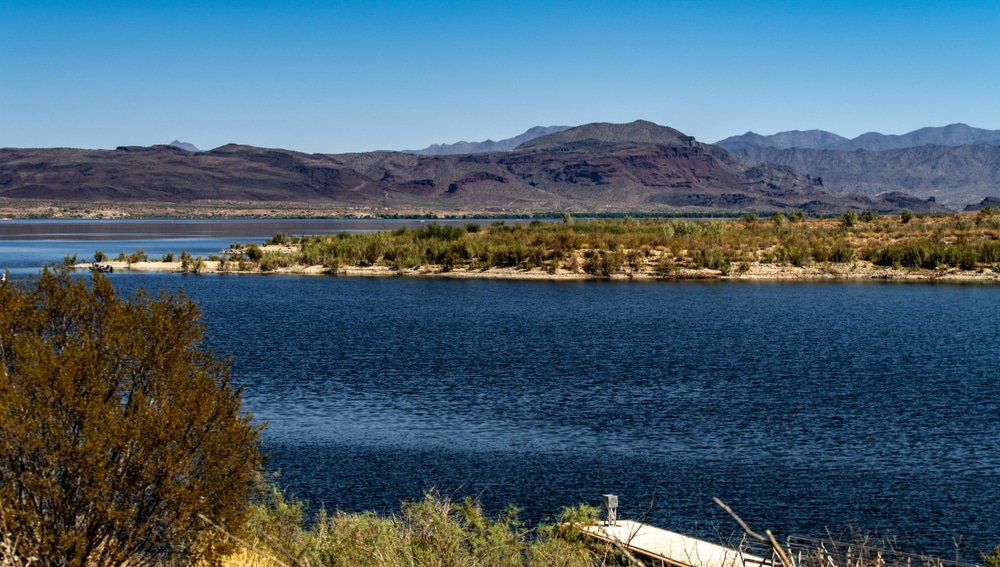
| Feature | Details |
|---|---|
| Location | Western Arizona, La Paz County |
| Established | 1969 |
| Size | Approximately 4,900 acres |
| Main Attraction | Alamo Lake (reservoir) |
| Activities | Fishing, boating, camping, hiking, wildlife viewing, stargazing |
| Popular Fish Species | Largemouth bass, crappie, bluegill, channel catfish |
| Camping Options | Developed campgrounds with hookups, primitive camping areas |
| Best Time to Visit | Spring and fall (milder temperatures) |
| Wildlife | Desert bighorn sheep, coyotes, bobcats, various bird species |
| Facilities | Boat ramps, fishing docks, picnic areas, restrooms, showers |
| Unique Feature | Known for excellent night sky viewing (minimal light pollution) |
| Climate | Hot desert climate with mild winters and very hot summers |
| Nearest Towns | Wenden, Salome |
| Entrance Fee | Yes (day use and overnight fees vary by season) |
Alamo Lake spans approximately 3,500 acres at normal water levels, creating a substantial aquatic environment in the midst of the arid Sonoran Desert. The lake is relatively shallow compared to other Arizona reservoirs, reaching depths of around 90 feet at full pool. With miles of shoreline to explore, visitors can discover numerous secluded coves and inlets perfect for fishing, paddling, or simply enjoying the tranquility of this desert oasis.
The creation of this impressive body of water began with the construction of Alamo Dam in 1968. This engineered marvel is an earthfill dam that rises 283 feet from the streambed, designed primarily for flood control on the Bill Williams River. The dam was a collaborative project between the Army Corps of Engineers and Arizona state agencies, with the primary purposes of protecting the Lower Colorado River area from floods originating in the Bill Williams River drainage while also providing water storage and public recreation opportunities.
One of the most fascinating aspects of Alamo Lake is its dynamic nature. The lake is subject to dramatic water level fluctuations based on rainfall patterns in its watershed. During flood events, the lake basin can capture enormous amounts of water in remarkably short periods – records show the lake rising as much as 11 vertical feet in a single night. This unpredictability adds to the lake’s character but also means visitors should check current lake levels before planning water activities.
The surrounding landscape features low-slung mountains and hills characteristic of the Sonoran Desert, with the Buckskin Mountains providing a dramatic backdrop. The terrain is speckled with native brush, wildflowers, and cacti, creating a visually pleasing experience for hikers and photographers. The Bill Williams River Valley, where the park is situated, represents a transition zone between different ecological zones, contributing to its biodiversity.
The watershed that feeds Alamo Lake consists of the Big Sandy River and Santa Maria River, which come together to form the Bill Williams River. This river system drains a significant portion of west-central Arizona, collecting seasonal monsoon rains and occasional winter precipitation that eventually finds its way to the lake. Downstream from the dam, the Bill Williams River continues its journey until it eventually joins the Colorado River near Lake Havasu.
The plant community at Alamo Lake State Park is classified as Sonoran Desertscrub, representing one of the most diverse desert ecosystems in North America. Common native trees include Palo Verde (Cercidium species), Ironwood (Olneya tesota), Catclaw Acacia (Acacia greggii), and Mesquite (Prosopis species). These drought-adapted trees provide crucial shade and habitat for wildlife while adding to the aesthetic beauty of the landscape.
What makes the vegetation particularly special at Alamo Lake is the diversity of cacti species found throughout the park. Majestic saguaros stand as sentinels across the hillsides, often reaching impressive heights and displaying their characteristic arm formations. Other cacti species include barrel cactus, cholla, prickly pear, and hedgehog cactus, each adapted to the harsh desert conditions with specialized water storage capabilities.
Spring transforms the normally arid landscape into a colorful display of wildflowers following winter rains. Visitors can enjoy carpets of purple owl’s clover, yellow brittlebush, and vibrant orange California poppies. These seasonal blooms not only enhance the scenic beauty but also provide important food sources for pollinators and other wildlife.
Wildlife viewing opportunities abound at Alamo Lake State Park. The area attracts both resident and migratory bird species, making it a popular destination for birders. Bald and golden eagles can be spotted soaring overhead or perched in trees along the shoreline, particularly in winter months. Great blue herons wade gracefully along shallow waters, while pelicans make seasonal appearances during migration periods. The desert surroundings host numerous songbirds, hawks, and owls throughout the year.
Mammals that call the park home include mule deer, foxes, coyotes, and the park’s famous wild burros. These burros are descendants of animals released by miners in years past and have successfully adapted to the desert environment. Visitors often encounter these charismatic animals along roadways or near the shoreline. More elusive residents include mountain lions, bobcats, and javelina, which generally avoid human contact but occasionally leave evidence of their presence for observant hikers.
The lake itself supports a diverse community of fish species, creating a thriving aquatic ecosystem that contrasts with the surrounding desert. The interconnection between water and land environments creates valuable habitat for numerous species, including some that are threatened or endangered, making Alamo Lake an important conservation area within Arizona’s arid landscape.
Alamo Lake State Park offers diverse camping options to suit various preferences and needs. The park features multiple campground areas with a total of over 200 sites spread across different locations. Campground A provides 17-21 basic sites with both back-in and pull-through configurations, ideal for tent campers or those seeking a more primitive experience. These sites include a picnic table and fire ring with grill, offering the essentials for a comfortable desert camping experience.
Campground B has expanded to include 42 sites with mixed amenities. Sites 1-27 offer electric and water hookups, perfect for RV campers seeking basic utilities, while sites 28-42 are designated for dry camping. Each site includes the standard picnic table and fire ring, with the electric sites particularly popular among visitors planning extended stays.
For those seeking full hookups, the park provides 19 full-service sites in Camp Area F, complete with water, electric, and sewer connections. These premium sites are often the first to be reserved during peak seasons, as they offer maximum convenience for RV campers. Additional electric-only sites can be found in the Ramada Area (12 sites) and Campground C (41 sites).
Dry camping options extend to Campgrounds D and E, providing more secluded sites for those seeking a closer connection to nature. The campgrounds are thoughtfully designed to accommodate various vehicle sizes, with some spaces able to handle RVs up to 90 feet in length. Campsite fees vary based on amenities, ranging from approximately $25 per night for basic sites to $40-50 for sites with hookups.
For visitors who prefer more substantial shelter, Alamo Lake offers four camping cabins overlooking the lake and Sonoran Desert. Each cabin features a covered wood porch, two single bunk-style beds with mattresses (accommodating up to four people), a table with four chairs, electricity, ceiling fans, lights, heat/air conditioning, and a lockable door. Outside, cabins include a picnic table, fire ring, and charcoal grill. Guests must bring their own linens, but the cabins provide a comfortable “glamping” experience that’s especially appealing during extreme weather conditions.
Campground amenities include regularly serviced restrooms located in each camping area, at the Visitor Center, and at each boat ramp. All restrooms are handicap accessible. Clean showers are conveniently available in camp areas A and C, as well as in the main campground. Dumpsters for trash removal are strategically placed throughout the camping areas.
Reservations are highly recommended, especially during peak seasons (spring and fall) and for weekend visits. Reservations can be made online through the Arizona State Parks website or by calling the Arizona State Parks Reservations Desk. The park’s remote location means that cellular service can be limited, so advance planning is advisable.
For those seeking accommodations beyond the park boundaries, options are extremely limited due to the remote location. The nearest established lodging is approximately 40 miles away in towns along Highway 60 such as Wenden or Salome. The Wayside Oasis, located about six miles east of the park, offers limited facilities including a restaurant with a sports bar atmosphere that can provide a change of pace for campers seeking social interaction.
Camping regulations at Alamo Lake emphasize conservation and respect for the fragile desert environment. Fires are permitted only in designated fire rings, and firewood is available for purchase at the park store. Quiet hours are enforced from 10:00 PM to 7:00 AM, with all music and generators required to be turned off during this time. The park’s remoteness enhances the camping experience with extraordinary night skies and the natural sounds of the desert, creating memories that draw visitors back year after year.
Alamo Lake State Park operates year-round, though visitor services may have seasonal adjustments. The park entrance and camping areas are open 24 hours a day, while the park office and store typically operate from 8:00 AM to 5:00 PM Arizona time (Arizona does not observe Daylight Saving Time). Reduced hours may apply on certain holidays, with specific scheduling for Thanksgiving and Christmas Eve.
Entrance fees are structured per vehicle rather than per person. Current rates are approximately $10 for a vehicle with one person, $20 for vehicles with 2-4 people, and $5 for individuals arriving by bicycle. These day-use fees are separate from camping fees. The park also honors the Arizona State Parks annual passes, which can provide significant savings for frequent visitors.
The best times to visit Alamo Lake State Park are during the milder seasons of spring, fall, and winter. Spring (March through May) is particularly spectacular, with desert wildflowers in bloom and comfortable temperatures for all activities. This is also prime time for bass fishing, as the spawning season typically occurs during these months. Fall (September through November) offers similarly pleasant conditions with fewer visitors. Winter brings cooler temperatures but generally remains mild enough for outdoor activities, with daytime highs typically in the 60s and 70s°F.
Summer months (June through August) bring intense heat to this desert region, with temperatures regularly exceeding 100°F. While the lake provides some relief from the heat, outdoor activities are best limited to early morning or evening hours during this season. The advantage of summer visits is significantly reduced crowds and often greater availability of preferred camping sites.
Weather patterns at Alamo Lake follow typical desert regimes, with dramatic temperature swings between day and night. Visitors should always be prepared for these fluctuations by dressing in layers. Rain is infrequent but can occur suddenly, particularly during the summer monsoon season (July-September), sometimes resulting in flash flooding in desert washes. Winter occasionally brings light frost but rarely experiences freezing conditions for extended periods.
Accessibility information is important for visitors with mobility concerns. The park has made efforts to accommodate all visitors with handicap-accessible restrooms throughout the facility and designated accessible camping sites. One of the camping cabins (Heron) features a handicap ramp. The visitor center and store are also accessible to wheelchair users. However, the natural desert terrain presents inherent challenges for accessibility, and some trails and shoreline areas may be difficult to navigate for those with mobility limitations.
Pet policies at Alamo Lake are relatively permissive. Pets are welcome in the camping areas and throughout most of the park but must be kept on leashes no longer than six feet at all times. Owners are required to clean up after their pets and should never leave animals unattended. Pets are not permitted in the camping cabins unless they are service animals. The desert environment presents hazards for pets including extreme heat, sharp cacti, and potential wildlife encounters, so owners should take appropriate precautions.
Cell service and internet availability are extremely limited at Alamo Lake due to its remote location. Visitors should not count on reliable cellular connections for communication or navigation. It’s advisable to download maps and information before arrival and to inform others of your travel plans. The park office can relay emergency messages if necessary, but general connectivity should not be expected as part of the experience. This disconnection from technology is considered a positive aspect by many visitors seeking to truly escape modern distractions.
The Visitor Center serves as the hub of park operations, housing the park office, ranger station, and park store. Here, visitors can obtain information about the park, purchase permits and passes, and learn about current conditions and wildlife sightings. The facility features interpretive exhibits showcasing the park’s diverse natural history, an aquarium displaying local fish species, and educational materials about the Sonoran Desert ecosystem. Rangers and staff are available to answer questions and provide recommendations for making the most of your visit.
The Park Store, located within the Visitor Center, offers a comprehensive selection of supplies for campers and day users alike. Fishing enthusiasts will find essential gear including bait, lures, fishing licenses, and seasonal live minnows (October-May). Boating supplies such as life jackets, boating flags, anchors, and other safety equipment are available for purchase. The store also carries firewood, ice, basic groceries, and personal hygiene items.
Beyond practical necessities, the store features park-specific merchandise including Alamo Lake shirts, hats, patches, walking sticks, pins, and books. Food items include ice cream, beverages, candy, condiments, hot dogs, buns, and ingredients for the campfire favorite: s’mores. This well-stocked facility ensures that even in this remote location, visitors can obtain needed supplies without leaving the park.
Restroom facilities are strategically located throughout Alamo Lake State Park, with facilities in each campground, at the Visitor Center, and at each boat ramp. All restrooms are handicap accessible, ensuring availability to all park visitors. Clean showers are conveniently located in camp areas A and C, as well as in the main campground, allowing extended-stay guests to refresh after a day of desert adventures. The park maintains these facilities regularly, with cleanliness being a consistently praised aspect of the Alamo Lake experience.
Picnic areas and ramadas provide comfortable spaces for day users and campers to gather for meals and social activities. Group ramadas are available in camp areas A and E, offering shade and facilities for larger gatherings. These covered structures provide essential protection from the intense desert sun, making outdoor dining pleasant even during warmer months. Group day-use areas include 60′ x 20′ ramadas with BBQ grills, available for a daily facility fee, perfect for family reunions or group events.
Boat ramps and water access points are crucial amenities at this lake-centered park. Two paved boat ramps provide reliable water access regardless of lake levels. The main boat ramp is located in the primary campground area, while a second ramp serves the Cholla campground. When water levels are exceptionally high, a third “High Water” ramp becomes available. These well-maintained facilities accommodate both motorized and non-motorized watercraft, with ample parking for vehicles and trailers.
For families with children, the park offers limited playground facilities in select camping areas. These recreational spaces provide younger visitors with opportunities for physical activity beyond water-based recreation. The open desert landscape also offers natural play spaces where children can explore (under supervision) and connect with the unique desert environment.
Additional specialized facilities include a fish cleaning station where anglers can properly prepare their catch. A dump station is available for RV campers needing to empty holding tanks, and dump ramps provide additional services for extended-stay visitors. An amphitheater occasionally hosts ranger-led programs and educational events, particularly during peak visitor seasons.
Concessions beyond the park store are limited due to the remote location. The on-site facilities focus on providing essential supplies and services rather than extensive commercial offerings, maintaining the natural, undeveloped character that makes Alamo Lake special. This simplicity contributes to the authentic outdoor experience that draws visitors seeking escape from commercialized recreation areas.
Conservation efforts at Alamo Lake State Park focus on balancing recreational use with protection of the unique desert ecosystem. The Army Corps of Engineers, which constructed Alamo Dam, works in coordination with Arizona State Parks to manage water levels that support both flood control objectives and ecological health. This partnership extends to the US Fish & Wildlife Service and Bureau of Land Management, which collaborate to maintain consistent stream flows in the Bill Williams River below the dam, preserving important riparian habitat downstream.
The park’s management of invasive species represents another important conservation initiative. Non-native plants and animals have been introduced to the area through various means, some accidentally and others purposefully. While some non-natives, like the feral burros that have become a beloved park symbol, have successfully integrated into the ecosystem, others require active management to prevent ecological disruption. Park staff monitor and work to control especially problematic invasive species that threaten native plants and animals.
Visitor responsibilities form a crucial component of conservation at Alamo Lake. The park emphasizes “Leave No Trace” principles, asking all visitors to pack out trash, stay on designated roads and trails, respect wildlife by maintaining appropriate distances, and minimize impact on the fragile desert ecosystem. Proper disposal of waste, including the use of designated dump stations for RVs, helps protect water quality in the lake. Conservation of water resources is particularly emphasized given the desert setting, with visitors encouraged to practice water-saving habits even while enjoying this aquatic oasis.
Volunteer opportunities allow passionate visitors to contribute directly to park maintenance and improvement. The Arizona State Parks volunteer program accepts applications from individuals willing to assist with various projects ranging from trail maintenance to visitor services. Some long-term volunteers serve as camp hosts, providing information to visitors and performing light maintenance duties in exchange for extended camping privileges. These dedicated individuals play an essential role in enhancing the visitor experience while supporting conservation goals.
Educational programs offered at Alamo Lake focus on building environmental awareness and appreciation for desert ecosystems. Ranger-led walks, presentations at the park amphitheater, and interpretive displays in the visitor center help convey the ecological and historical significance of the area. The Junior Ranger program engages younger visitors in age-appropriate conservation activities, fostering the next generation of environmental stewards. These educational initiatives help visitors understand the delicate balance of desert ecology and the importance of protecting these special places.
Leave No Trace principles are prominently promoted throughout the park, with specific emphasis on fire safety in this arid environment. Visitors are instructed to build fires only in designated fire rings, completely extinguish all fires, and never leave fires unattended. Water conservation, proper waste disposal, and respect for wildlife and plant life are similarly emphasized as part of the park’s comprehensive approach to visitor education.
Through these combined efforts of management agencies, staff, volunteers, and conscientious visitors, Alamo Lake State Park maintains its dual mission of providing outstanding outdoor recreation opportunities while preserving the ecological integrity of this remarkable desert landscape for future generations to enjoy.
P.O. Box 38
Wenden, AZ 85357
GPS Coordinates: 34.2325° N, 113.5606° W
From Phoenix: Take US-60 west for approximately 125 miles to Wenden. Turn north on Alamo Road and continue for 38 miles to the park entrance.
Phone: (928) 669-2088
Website: azstateparks.com/alamo-lake/
Park: 24 hours daily
Visitor Center/Store: 8:00 AM – 5:00 PM
(Reduced hours on select holidays)
Day Use: $10-20 per vehicle
Camping: $25-50 per night, depending on amenities
Cabins: Rates vary by season
